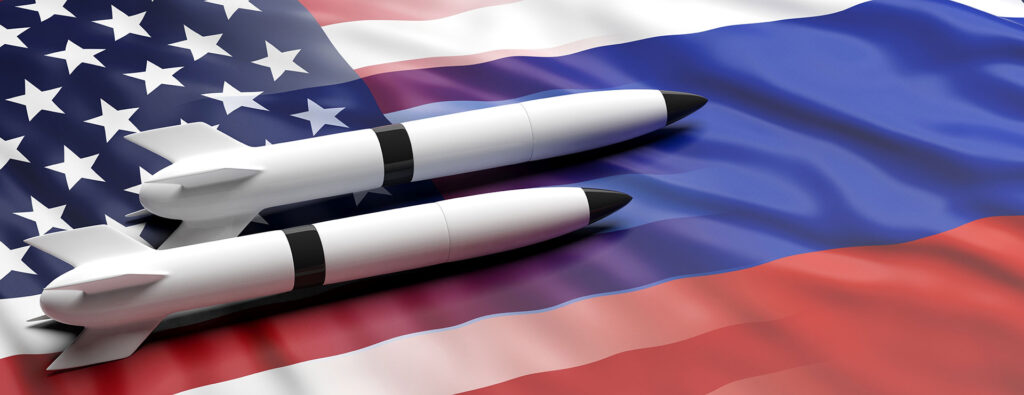While all eyes are on Ukraine, the Arctic is heating up. On May 8, NATO kicked off “Formidable Shield,” a three-week military exercise. The exercise is intended to showcase the strength of the NATO alliance and its commitment to the defense of Europe.
As many as 13 NATO allied and partner nations with more than 20 ships, and 35 aircraft, including the F-35 fighter, and 4,000 personnel are participating in this exercise. As per the Pentagon “encompasses live-fire rehearsal events in a multidomain environment against subsonic, supersonic and ballistic targets.” In effect, this exercise is a shot across the bow of Russia.
Moscow has been active in the Arctic for decades. In 2007, two mini submarines (mini-subs) planted a one meter-high titanium Russian flag more than two and a half miles beneath the North Pole. In a record-breaking dive, the mini-subs Mir-1 and Mir-2 descended to 4,300 meters. In Moscow’s words, this was “a serious, risky and heroic mission.”
Riches Under the Sea and Across it too
It is an open secret that global warming is accelerating and climate change is already upon us. NASA tells us that polar ice is melting dramatically and Greenland is losing about 270 billion tons per year. This is leading to sea level rise, which will be catastrophic for the likes of Bangladesh, Maldives and New Orleans but offers polar powers access to natural resources and new trade routes.
The Arctic has major reserves of oil and natural gas. Large quantities of minerals, including iron ore, copper, nickel, zinc phosphates and diamonds, are also on offer. In 2008, the United States Geological Survey estimated “90 billion barrels of undiscovered, technically recoverable oil, 1,670 trillion cubic feet of technically recoverable natural gas, and 44 billion barrels of technically recoverable natural gas liquids in 25 geologically defined areas” in the Arctic.

The melting of the Arctic is also opening up new trans-Arctic routes, including the Northern Sea Route (NSR) and the Northwest Passage (NWP). The NSR and NWP are shorter maritime routes. They offer an economic boost to Arctic economies. New ports, both hydrocarbon and military, are opening in the region. With such riches on offer, the US, Russia, Canada, Denmark, Norway, Sweden, Finland and Iceland stand to gain.
Russia Ahead in Great Arctic Race
A great Arctic race is now on. As a resource-based economy that exports commodities, Moscow is taking the lead in the militarization and resource grab in the region. Elizabeth Buchanan, the author of Red Arctic, chronicles how Russia has cannily used “international rules for over two decades to secure its rights in the North Pole seabed.”
Russia ratified the United Nations Convention on the Law of the Sea (UNCLOS) in 1997. Since then, Moscow has worked ceaselessly for the recognition of its claims to the extended continental shelf. The Commission on the Limits of the Continental Shelf (CLCS) has deemed the majority of Russia’s claims in the Arctic to be valid. This February, Moscow gained rights to an approximately 1.7 million square kilometers of seabed.
Russia has used international law to its advantage because UNCLOS allows coastal states to establish the outer limits of their continental shelves beyond the limits of 200 nautical miles. The CLCS seeks scientific data and Russia has been diligent in providing this evidence. It also made its claims to the CLCS first. Danish (thanks to control of Greenland) and Canadian claims came later and might be a decade away from recognition. The US does not recognize UNCLOS and thus cannot make claims to the extended continental shelf.
While bolstering its legal claims, Russia has been building military strength in the Arctic. Last September, Reuters reported that “Russia has reopened tens of Arctic Soviet-era military bases, modernized its navy, and developed new hypersonic missiles designed to evade US sensors and defenses” since 2005. Russia’s bases inside the Arctic Circle outnumber NATO’s by about a third and the West is at least ten years behind.
Russia has seven nuclear-powered icebreakers and around 30 diesel-powered ones. The US and China have just two diesel-powered icebreakers each in operation. The US is the global superpower but Russia is the Arctic superpower.
Apart from resources and sea routes, the Arctic offers some of the best places to station ground stations for satellites. One such place is the island of Svalbard off the Norwegian mainland. SvalSat in Svalbard downloads time-sensitive data from most of the world’s commercial and scientific satellites. In 2021 and 2022, fiber-optic cables on the Arctic seabed connecting the island and the mainland were severed. Norwegians suspect the Russians of sabotage.
Norway is not alone in worrying about Russia. In the 1939-40 war, Finland lost 11% of its territory to the Soviet Union, which was then led by Joseph Stalin. Finns view Russian President Vladimir Putin as a grave threat to national security. In their eyes, he has reverted to expansionism that characterized both Stalin and the Tsars. In November 2022, Putin launched two nuclear-powered icebreakers capable of year-round navigation in the Western Arctic. Russian “Arctic power” is making its neighbors nervous. Exercises like Formidable Shield demonstrate that the US-led NATO can act in the Arctic.
The West Also Worries About China
China also has Arctic ambitions and claims to be a near-Arctic state. The United States Naval Institute tells us that “China is subtly installing a larger presence in the Arctic through an extensive partnership with Russia in areas ranging from multi-use ports and airfields to energy extraction.”
A Brookings paper tells us that Chinese President Xi Jinping and officials responsible for Arctic policy want their country to be a top polar power by 2030. They see this region as one of the “new strategic frontiers” where China can quench its thirst for energy and minerals. Some concerns about the future Chinese play for the Arctic seem overblown. What makes sense is that Chinese demand might fuel Russian supply.
The two countries are inching closer together even though China has not fully backed Russia on Ukraine. They have conducted naval exercises together in the Arctic. In 2021, Russian and Chinese ships circumnavigated Japan’s main island Honshu in a naval exercise of immense significance. China is the workshop of the world. Its demand for oil, natural gas and all the minerals under the Arctic is immense. It has the money to invest into Russian polar infrastructure from ports and naval vessels to pipelines and other infrastructure.
The opening up of trans-Arctic routes would allow these to be transported to Chinese ports at much cheaper rates than today. So, China has a stake in the Arctic and is therefore making a strategic bet by cozying up with Russia. Talk of polar silk roads is rife. Together, Russia and China could make a formidable Eurasian alliance, especially in the Arctic, despite their rivalry in Central Asia and elsewhere.
What Lies Ahead?
In August 2017, the Russian tanker sailed from Norway to South Korea in 19 days without needing an icebreaker. This Arctic passage along the conventional route through the Suez Canal would have taken over 50 days. In 2018, The Economist opined that “the Arctic route has drawbacks: a navigation season of three to four months each year, unpredictable ice conditions, high insurance fees, costly specialised vessels, and a lack of search-and-rescue teams and support infrastructure.”
The increasing rate of the melting of the poles might mitigate these drawbacks. Furthermore, instability and piracy along the traditional routes, especially in the Middle East and the Horn of Africa, might add costs to traditional shipping. The Suez Canal and the Straits of Malacca could clog up. For China, they are trade arteries that could be cut off. The Arctic passage is far better for Chinese national security.
With the Russians beefing up their military in the region and the Chinese bankrolling them, the Arctic is set to change. The other Arctic powers will not stand idly by. They will inevitably respond both diplomatically and militarily. The mood in Washington is already increasingly belligerent. In December 2022, Kenneth R. Rosen argued in Politico that a battle for the Arctic was already underway and the US was behind. As the US gears up and its allies join in, the Arctic will heat up further and become a new theater for potential conflict.
The views expressed in this article are the author’s own and do not necessarily reflect Fair Observer’s editorial policy.
Support Fair Observer
We rely on your support for our independence, diversity and quality.
For more than 10 years, Fair Observer has been free, fair and independent. No billionaire owns us, no advertisers control us. We are a reader-supported nonprofit. Unlike many other publications, we keep our content free for readers regardless of where they live or whether they can afford to pay. We have no paywalls and no ads.
In the post-truth era of fake news, echo chambers and filter bubbles, we publish a plurality of perspectives from around the world. Anyone can publish with us, but everyone goes through a rigorous editorial process. So, you get fact-checked, well-reasoned content instead of noise.
We publish 2,500+ voices from 90+ countries. We also conduct education and training programs
on subjects ranging from digital media and journalism to writing and critical thinking. This
doesn’t come cheap. Servers, editors, trainers and web developers cost
money.
Please consider supporting us on a regular basis as a recurring donor or a
sustaining member.
Will you support FO’s journalism?
We rely on your support for our independence, diversity and quality.






Comment